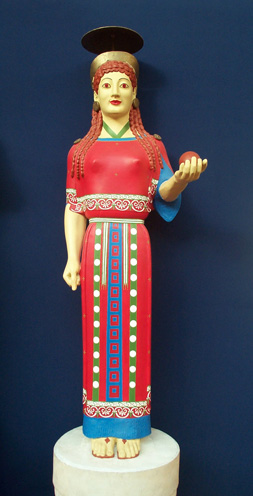
- Find out about our unrestored cast of the Peplos Kore (34)
Athens Acropolis Museum 679
Purchased in 1975 from Dresden
Lippold: Griechische Plastik, 77 (n.9), pl. 23.2
Karo: Personality in Greek Archaic Art, 264-
Schrader: Archaischen Marmorbildwerke des Akropolis (1939), 45-, pl. 1 (for colour)
Payne & Young: Archaic Marble Sculpture from the Acropolis, 18-
Cook: Journal of Hellenic Studies 96 (1976), 153-4 (for colour and meniskos)
Lehmann: Altgriechische Plastik, 52-57, pl. XVIII (for colour)
Efemeris Archaiologike: 1887, pl. 9 (for colour)
Ridgway: Journal of the Walters Art Gallery, XXXVI (1977)
Cook: Journal of the Walters Art Gallery, XXXVII (1978)
Stewart: Greek Sculpture, 123, pls. 147 &149
Panzanelli (ed.): The Color of Life (2008), 126
American Journal of Archaeology, vol 112 no 2 (April 2008), 347-351
Discovered in 1886 on the Acropolis, Athens
